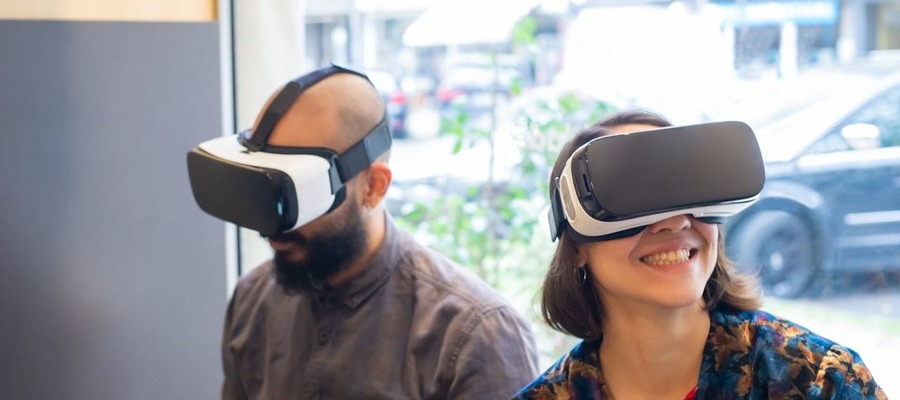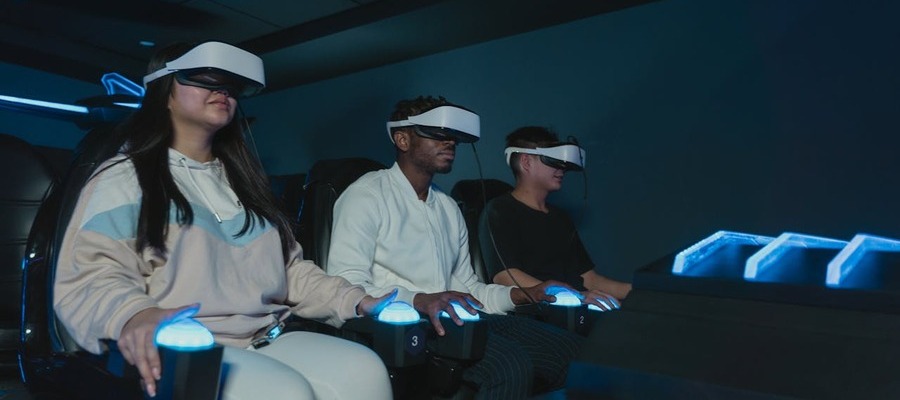Artificial Intelligence (AI) and Augmented Reality (AR), or AR AI, are transforming industries. In this article, you’ll learn how augmented reality work integrates with various applications and industries, enhancing healthcare, education, and retail by offering personalized, efficient experiences within an AR environment. Discover key applications, technical improvements, and future trends in AI-enhanced AR systems.
Key Takeaways
- The integration of AI and AR enhances user experiences through personalized, immersive interactions within an AR environment across various sectors, including healthcare, education, and retail.
- AI optimizes augmented reality work with improved object recognition, tracking, and real-time data analysis, offering users adaptive and engaging experiences.
- Challenges such as privacy concerns and computational limitations must be addressed to enable the overall adoption of AI-enhanced AR technologies.
What is Augmented Reality (AR) and Artificial Intelligence (AI)?

Augmented Reality (AR) is a creative technology that overlays digital information onto the physical habitat, creating an AR environment that enhances our interaction with the world around us. Imagine walking through a city and seeing digital directions, restaurant reviews, or historical facts superimposed on your view. This is the power of AR technologies, transforming how we perceive and engage with our surroundings.
Artificial Intelligence (AI), on the other hand, is a branch of computer science concentrated on creating systems capable of carrying out tasks that typically require human intelligence. These tasks include learning, reasoning, problem-solving, and understanding natural language. When AI and AR technologies converge, they create powerful applications that revolutionize various industries. From personalized shopping experiences to advanced medical procedures, the integration of AI and AR is paving the way for a future where digital and physical realities seamlessly blend.
Understanding AI and AR: A Synergistic Relationship
Artificial Intelligence (AI) and Augmented Reality (AR) are two of the most exciting technological advancements of our time. AI focuses on making systems that can reason, learn, and act independently, while AR superimposes digital content onto the physical world, building a seamless blend of virtual and real environments. When these two technologies converge, they unlock new dimensions of user experiences, enhancing interactivity and personalization in ways previously unimaginable.
Augmented reality work integrates with various applications and industries, enhancing user experiences through interactive and immersive aspects.
AI processes data, predicts outcomes, and adapts in real-time to user inputs, making AR experiences more engaging and responsive. AI algorithms analyze user conduct and preferences to offer tailored content. This can range from virtual tour guides in museums to educational apps that adjust to a student’s learning pace, transforming interactions with the world.
The synergy between AI and AR is wider than just entertainment and education. These technologies are making significant strides in diverse fields, such as healthcare and retail, improving user engagement and operational efficiency. Combining AI’s data processing and AR’s immersive visuals ushers in an era where digital and physical realities merge, creating meaningful and impactful experiences.

Key Applications of AI in AR Technologies
Integrating AI with AR is transforming industries by offering personalized, dynamic, and efficient experiences within an AR environment. Augmented reality work revolutionizes various sectors by providing interactive and immersive applications and enhancing user experiences through advanced tracking and object recognition technologies. Here are key applications in healthcare, education, and retail.
Healthcare Innovations
In healthcare, AI and augmented reality work within an AR environment are game-changers. AR provides real-time guidance and essential information during surgeries. Imagine a surgeon who can see a 3D model of the patient’s anatomy superimposed on their actual body, allowing for precise and confident incisions. AI improves surgical procedures through real-time data analysis and visualization, boosting precision and patient outcomes.
The fusion of AI and AR within an AR environment allows surgeons to visualize anatomy in 3D, enhancing surgical accuracy. This integration enhances surgical precision and streamlines preoperative planning and postoperative care, improving patient outcomes.
These cutting-edge technologies usher in a new era of precision and personalized patient care in healthcare.
Educational Enhancements
In education, augmented reality work and AI create immersive learning experiences within an AR environment that captivate students. AR helps students visualize complex concepts and interact with virtual reality environments, making learning more interactive. For example, a history lesson can transform into a virtual tour of ancient Rome, where students can explore historical landmarks in their physical environment.
AI algorithms adapt educational content to individual learning styles and paces, aiding deeper understanding.
AI-driven chatbots in AR create immersive environments where learners interact with virtual tutors, enhancing the educational experience. Combining AI and AR makes learning both more engaging and effective.
Retail Transformations
The retail industry is transforming with AI and augmented reality work within an AR environment. AI analyzes user preferences and behaviors, facilitating personalized shopping experiences in AR. Customers can use AR to virtually try on products like clothing or makeup from home, enhancing the shopping experience and reducing returns.
A prominent retail brand uses AI to boost customer satisfaction and sales through personalized recommendations and efficient inventory management. AI-driven product recommendations are tailored based on customer behavior, improving sales effectiveness and customer loyalty.
Integrating AI and AR allows the retail industry to create more fascinating and personalized shopping experiences.
Remote Assistance and Maintenance with AR
Remote assistance and maintenance are among the most impactful applications of AR technology. Imagine a technician working on complex machinery who can receive real-time guidance through an AR headset. AI-powered AR systems can overlay step-by-step instructions directly onto the technician’s field of view, creating an adaptive AR environment that boosts productivity and reduces errors.
AI algorithms play a crucial role in these systems by enabling the AR technology to recognize and interact with real-world objects. For instance, the system can identify a specific part of the machinery and provide relevant instructions or warnings. This dynamic interaction creates an environment that adapts to the user’s actions, making the maintenance process more efficient and intuitive.

How AI Algorithms Improve AR Systems
AI algorithms enhance the AR environment with accurate object recognition, tracking, and real-time spatial mapping.
Augmented reality work relies on accurate object recognition, tracking, and real-time spatial mapping to create interactive and immersive experiences.
Here are the technical aspects of how AI improves AR systems, focusing on object recognition, tracking, and real-time data analysis.
Object Recognition and Tracking
AI object recognition algorithms accurately classify and identify items in real-world settings, enhancing interaction within an AR environment. Using machine learning and computer vision, these algorithms enable AR systems to recognize and track objects in real-time, enhancing user experience. Segmentation algorithms help distinguish between foreground objects and background, making AR functionality more seamless and intuitive.
AI’s object detection capabilities and AR impact various real-world applications. AI and AR integration in robotics helps robots navigate and interact effectively, improving functionality and usefulness. In industrial automation or consumer robotics, real-time object tracking and recognition is a game-changer.
Real-Time Data Analysis
Real-time data analysis is another critical area where AI enhances the AR environment. AI algorithms process live data to dynamically adapt AR experiences, making them more interactive and engaging. Real-time data processing allows for instant adjustments in AR applications, ensuring users receive the most relevant and personalized information.
Users experience more personalized interactions with AR content, resulting in better engagement and satisfaction. For instance, an AR navigation app can offer real-time guidance and updates based on the user’s location and traffic conditions.
Integrating AI in processing real-time data ensures immersive and highly adaptive AR experiences that instantly cater to user needs.
Immersive Experiences with AR and VR
Augmented Reality and Virtual Reality are two pillars of the broader field known as Extended Reality (XR). While VR immerses users in a totally virtual environment, AR enhances the physical environment by overlaying digital content, creating an engaging AR environment. The synergy between AI and AR has opened up new dimensions of user experiences, driving innovation across various sectors.
For example, in the retail industry, AI-powered chatbots and virtual assistants transform customer interactions. These intelligent systems utilize natural language processing to understand and react to customer queries, providing personalized assistance and recommendations. By integrating AI with AR, businesses can offer immersive shopping backgrounds where customers can virtually try on products or envision how furniture would look in their homes. This blend of virtual and physical environments enhances customer satisfaction, drives sales, and reduces return rates.

AI-Powered Chatbots and Virtual Assistants
AI-powered chatbots and virtual assistants revolutionize customer service by providing instant, personalized assistance. Because they use machine learning and natural language processing, these intelligent systems can understand and process human language, making interactions more natural and efficient.
AI algorithms enable chatbots to adapt their responses based on the context and the individual needs of the user within an AR environment. For example, a virtual assistant in an e-commerce platform can help customers find products, track orders, and resolve issues while maintaining a conversational tone. This level of personalization enhances customer satisfaction and streamlines the resolution of queries and concerns.
In addition to customer service, AI-powered virtual assistants are being used in various other applications, such as healthcare, where they can provide patients with information and support, and in education, where they can assist students with their learning needs. By continuously learning and improving, these AI systems are becoming increasingly adept at providing valuable and efficient assistance across different domains.
Overcoming Challenges in AI-Enhanced AR
While AI and AR integration offers many benefits, it also presents challenges such as computational requirements and privacy concerns that need addressing for a seamless AR environment. Augmented reality work faces similar challenges, including the need for advanced tracking and object recognition technologies.
Let’s explore these challenges in more detail.
Addressing Privacy Concerns
Privacy and data security are primary concerns in AI and AR implementation within an AR environment. Ethical issues regarding personal data collection and use are growing. In mixed reality environments, data privacy and digital rights are significant ethical issues that need addressing to foster trust and encourage adoption.
To mitigate privacy risks, the industry actively implements safeguards and regulations, including data security, user consent, and responsible AI usage. Addressing privacy concerns is crucial for fostering trust and encouraging wider adoption of AI and AR technologies.
Computational and Integration Hurdles
Real-time visual data processing is critical for effective AI integration in an AR environment, posing challenges for mobile devices with limited processing power. Adequate processing power ensures seamless AR user experiences. Developers need to optimize applications to balance performance and functionality effectively.
Integrating AI and AR requires sophisticated neural networks and machine learning algorithms to handle complex computations and data analysis. Overcoming these computational and integration hurdles is crucial for successfully deploying AI-enhanced AR applications.
Ethical Considerations in AI and AR
As AI and AR technologies continue to advance and converge, it’s essential to address the ethical considerations that arise from their integration. The use of AI in AR environments raises concerns about data privacy, bias, and transparency.

Future Trends in AI and AR Technologies
The future of AI and AR technologies is promising, with the AR market projected to grow to $39.8 billion by 2027. This growth is caused by advancements in AI algorithms that enhance AR realism by optimizing rendering for detailed graphics and textures. Real-time data analysis and pattern recognition improve AR interactions, creating more engaging and personalized experiences.
Future advancements in AI algorithms will enhance the AR environment, creating more engaging and personalized experiences.
As AI and AR technologies evolve, expect exponential growth in their integration, leading to transformative experiences that enhance lives and improve the world. The potential applications of extended reality are vast, from smart glasses providing real-time information overlays to advanced machine learning algorithms tailoring AR experiences to users.
Developers and companies should focus on creating intelligent AR applications that leverage AI for personalized and immersive experiences. Staying ahead of these trends will enable them to create innovative solutions that meet evolving user needs and drive the future of AI and AR technologies.
Creating AI-Powered AR Experiences
Creating AI-powered AR experiences requires using development platforms and tools designed to seamlessly merge digital and physical worlds within an AR environment. Development platforms and tools are essential for creating effective augmented reality work and integrating AR technology with various applications and industries. Google ARCore offers cross-platform APIs to help developers create immersive AR experiences, allowing users to interact with digital content in their environment. Unity provides a specialized platform for creating engaging AR content equipped with tools for cross-device workflows.
Adobe Aero is an intuitive AR authoring tool that enables creators to easily design and share immersive storytelling experiences. For location-based AR, Wikitude offers robust support through various applications. MetaSpark Studio allows developers to build and share AR experiences with target tracking and depth mapping features.
Other notable tools include Apple’s Reality Kit, which enhances AR development by providing tools for realistic integration of virtual objects into real environments, and NVIDIA’s CloudXR technology, enabling high-quality streaming of AR experiences from remote servers to various devices. By leveraging these tools, developers can create cutting-edge AI-powered AR experiences that captivate users.
Case Studies: Successful AI and AR Integrations
Real-world examples of successful AI and AR integrations highlight their transformative potential. Niantic, known for Pokémon GO, built a platform that promotes community engagement through AR experiences. In gaming, AI enhances AR by adapting gameplay to players’ actions, making interactions more engaging and dynamic. Augmented reality work in gaming and collaborative workspaces showcases its transformative potential.
Collaborative AR workspaces use AI-powered chatbots to facilitate communication and task management within an AR environment, improving productivity in virtual meetings. Success factors for AI integration across industries include high-quality data, interdepartmental collaboration, and ongoing AI system training.
These case studies show how AI and augmented reality experiences can create immersive and impactful experiences.
Concluding Remarks
The synergy between AI and AR technologies is opening new horizons in various fields, from healthcare and education to retail and entertainment, all within an AR environment. Augmented reality work is enhancing user experiences through real-time data analysis, object recognition, and personalized content, transforming how we interact with the world. Despite challenges such as computational requirements and privacy concerns, the future of AI and AR is incredibly promising.
As we look ahead, the potential for AI and AR to enhance lives and improve the world is immense. Developers and companies must continue to innovate and create intelligent AR applications that meet users’ evolving needs. With continued advancements and successful integrations, AI and AR technologies will surely shape the future of our digital and physical worlds.
Frequently Asked Questions
1. How do AI and AR technologies complement each other?
AI complements augmented reality work by enhancing data processing and real-time adaptability within an AR environment, resulting in improved user interactions. Together, they create more immersive and responsive experiences.
2. What are some applications of AI in AR technologies?
AI in AR technologies, or augmented reality work, significantly improves healthcare, enhances educational experiences, and transforms retail environments within an AR environment. These applications showcase the potential of integrating AI to create more immersive and efficient user experiences.
3. What are the challenges in integrating AI with AR?
Integrating AI with AR and augmented reality work presents challenges such as high computational requirements, privacy concerns, and the necessity for substantial processing power within an AR environment. These factors must be addressed to achieve effective integration.
4. What tools can developers use to create AI-powered AR experiences?
Developers can use various tools to create effective augmented reality work, including AI-powered AR experiences within an AR environment, with platforms such as Google ARCore, Unity, Adobe Aero, Wikitude, Apple’s RealityKit, and NVIDIA’s CloudXR. Each tool provides unique features that facilitate the development of immersive augmented reality applications.
5. What are some successful examples of AI and AR integrations?
Successful examples of AI and augmented reality work within an AR environment include Niantic’s Pokémon GO and AI-enhanced gaming experiences and collaborative AR workspaces utilizing AI-powered chatbots. These applications showcase the innovative potential of combining these technologies.



